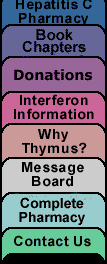By Ransdell
Pierson
NEW YORK (Reuters) -
Schering-Plough Corp., which rocked Wall Street with a warning
its earnings will fall again next year, owes much of its troubles
to falling sales of a hepatitis C therapy.
The company, already hit by plunging sales of allergy drug
Claritin, next year will likely see its hepatitis drugs eclipsed
by a cheaper and more convenient treatment recently launched
by Roche Holding AG, doctors and analysts said.
Schering-Plough's combination therapy against the hepatitis
C virus was introduced two years ago and is now the company's
biggest product line. It includes a long-acting interferon
medicine called Peg-Intron and the antiviral pill ribavirin.
Sales of the therapy fell 14 percent to $569 million in the
second quarter, hurt by Roche's injectable Pegasys interferon
and its version of ribavirin, called Copegus.
"We are seeing a downward slope in sales of our biggest
products, including Peg-Intron," Chief Executive Fred
Hassan told Reuters in an interview.
Decline of the Schering-Plough hepatitis business comes at
the worst possible time, just months after the U.S. patent
on Claritin expired. Sales of the allergy pill, once $3 billion
a year, have tumbled almost 90 percent now that it is being
sold over the counter at a fraction of its previous price.
The Kenilworth, New Jersey-based drugmaker expects 2003 earnings
to fall by two-thirds, and it has slashed its dividend to
preserve cash. Its shares sank to a six-year low on Friday
after it warned profits will decline again next year.
Hassan, who was hired earlier this year to turn around the
company, said Roche spurred sales of Pegasys largely by giving
away the first three months of treatment to 15,000 American
patients. The same patients then had to pay for remaining
months of therapy.
About 4 million Americans are believed infected with the
hepatitis C virus, which is the biggest cause of liver transplants.
The virus quietly attacks the liver for decades before symptoms
develop, but can be eliminated with the Roche and Schering-Plough
drugs.
"Roche's marketing skills are alarming Schering-Plough,
which had taken its own hepatitis products for granted and
assumed they would prevail in the leadership role," said
Sena Lund, a drug analyst for Cathay Financial LLC.
The Schering-Plough SGP.N combination had a U.S. monopoly
until Swiss drugmaker Roche ROCZg.VX launched its rival drugs
in January, pricing its ribavirin at an approximate 43 percent
discount.
Pegasys now boasts a 42.1 percent share of the U.S. market
for long-acting interferons, leaving Peg-Intron with less
than 58 percent, according to SG Cowen analyst Steve Scala.
Sund said the combined wholesale cost of Roche's two medicines
is $23,000 for a year's course of treatment, versus $26,000
for Schering-Plough's.
That cost advantage could allow Roche's products to catch
up with or overtake Schering-Plough's by year's end, he added,
even if other companies launch cheaper generic forms of ribavirin.
"Schering-Plough now has to lower its prices or do something
else to protect its market share," Sund said.
Pegasys has also become popular with many doctors and patients
because it comes pre-mixed in a single vial, which is drawn
by a syringe and injected once a week. All patients take the
same fixed dose.
By contrast, Peg-Intron requires patients to use two syringes
and two vials in a process that combines a liquid and a powder.
In addition, the dose must be adjusted by body weight.
"I personally now only prescribe Pegasys because so
many patients say it is so much easier to use than Peg-Intron,"
said Dr. Samuel Daniel, chief executive at North General Hospital
in New York, who noted Roche has financial ties to the hospital.
Schering-Plough hopes to win U.S. approval for a pen-like
device that would allow patients to inject Peg-Intron directly,
without need to mix vials. But the company has not predicted
when it will be launched or how many patients will embrace
it.
Although the battling therapies have never been compared
head-to-head in clinical trials, many doctors consider them
similarly effective and well tolerated.
Dr. Mitchell Shiffman, a professor at Virginia Commonwealth
University Health System, said the greater convenience of
Roche's combination therapy could make it the preferred choice
within a year.
Schering-Plough is attempting to stem Roche's assault by
suggesting that Peg-Intron -- with its personalized dosing
-- may be more appropriate for overweight patients than Pegasys.
But it acknowledges a trial directly comparing the two drugs
would be needed to draw firm conclusions.
SOURCE
HAVE WE COME TO THIS, IF IT IS EASY, WE WILL
TAKE IT?
MAY GOD HAVE MERCY ON US!
LLOYD
|


